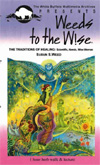www.susunweed.com
Herbal Adventures with Susun S Weed
The Polygonaceae family - knotweed, buckwheat, or smartweed family
as seen printed in www.sagewoman.com
Herbs that we can eat and use for medicine grow all over our planet. It's fun to travel and meet new herbs, or to read about, and then buy, the latest greatest green from someplace exotic. But I'm a great champion of using the plants that grow nearest to us: the weeds. Weeds pack a powerhouse punch of vitamins and minerals, reawaken our "wild woman" selves, and form the basis of most of my self-help medicines. I'm about to introduce you to a whole family of troublesome weeds. Despite their naughty ways, I'm sure you'll like them.
If you have a garden, or access to a vacant lot or a farm, you'll surely find one or more members of the fascinating "many knees" family. The Polygonaceae (poly is "many," gona is "knee," as in genuflect) family is also known as the knotweed, buckwheat, or smartweed family. When I asked a couple of local farmers about smartweeds, one told me: "You got to be smart to know which ones to eat." His friend did not agree: "If you eat the wrong one, your tongue will smart!" he grinned.
Whether your tongue is smart or smarting, no need to worry. There are no poisonous members of the "many knees" family, at least above ground. All the knotweeds produce edible (though not always delicious) greens and seeds. Below ground is a different story. Some dock roots are such violent cathartic laxatives that they are the next best thing to poisonous. "Many knees" refers to their swollen joints, or knots, which are usually found most easily by looking at the flowering stalk, right where the leaf meets the stalk. The knee is often covered by a conspicuous papery sheath, perhaps the plant equivalent of a silk stocking?
One of the most stately ladies in this family -- and one who is always wearing her silk stockings -- is Miz Ruby Rhubarb (Rheum palmatum). She's also known as Chinese rhubarb, or turkey rhubarb, or one powerful way to blow out your colon. When men (and a few women) went to sea to kill whales, they subsisted on a diet of dried salted meat, dried beans, hardtack, and beer or rum. Not the kind of diet the doctor -- or the wise woman -- would recommend for regularity. Ruby provided that; she is one of the most regular women I know. The ships took on thousands of pounds of her, and the ships' hands--from the captain to the youngest boy--got a weekly dose of rhubarb root boiled in water. Watch out below!
A more common, but just as beautiful, member of the "many knees" family is yellow dock (Rumex crispus). She has a heart of gold, but a will of iron. Women everywhere use her as an iron tonic, especially during pregnancy. (There's a recipe in Wise Woman Herbal for the Childbearing Year.) Her ability to improve digestive functioning -- by nourishing and tonifying the liver, stomach, spleen, and gall bladder -- as well as her tendency to get things moving makes her ideal for the latter months of parturition. She also has quite the reputation for giving cancer an eviction notice.
"Dock" refers to any plant with big leaves. So the plant with big leaves and burrs is "burdock." And the big-leaved one where fairies play is called "elfdock" (another name for elecampane). An old name for comfrey is "heal-dock" since its big leaves heal everything. Yellow dock has big leaves too, and a yellow root. (And of course there's Bugs Bunny's favorite plant: "What's up doc?")
There are many related many-knee yellow docks including Rumex crispus (curly dock), R. acetosa (sour dock), R. acetosella (sheep sorrel), R. alpinus (Monk's rhubarb), R. aquatica (red dock), R. aquaticus (water dock), R. hymenosepalus (wild pie plant), R. mexicanus (Mexican dock), R. obtusifolius ( bitter dock), patientia (patience dock), R. scutatus (French sorrel), and R. verticillatus (swamp dock). No matter where you live, you ought to be able to make the acquaintance of my friend Mama Dock.
Her towering hennaed hair-do is one of the easiest ways to pick her out of the crowd. (To the botanist it's a seed head, not a hair-do.) Her strap-like leaves are not that difficult to identify either. They are tasty cooked by themselves or with other spring greens. They are the star of a Russian soup I know as Shav.
By mid-summer there's hardly a yellow dock leaf to be seen, but the flowering stalks are rising, rising, some up to 4 feet. Her flowers are green, not flashy, but en masse (especially if you find a field of sheep sorrel blooming) they have a faint reddish hue which hovers like a haze around them. The flowers mature into russety reddish-brown seeds which stay on the stalk for months, providing important nutrition to birds when snow covers the ground.
Those seeds are not just related to buckwheat, they are wild buckwheat. I harvest them when they are mature and dark brown. If I wait too long they get too wet or too buggy. I harvest on a sunny day and lay the seedheads on shallow paper-lined trays to dry.
To prepare the seeds, I strip them off the stalks and rub them briskly between my palms. While not sharp, the seeds and stalks are abrasive, so you may want to wear gloves if you are going to process a lot. It is nicest to do this outside in a light breeze. With a little practice, you can get the wind to take the husks away for you. Inside, you will need to use a sieve with holes too small to allow the seeds through, but big enough to pass the husks. Don't worry if some husk is still in with the seeds. They won't hurt you; they're just bitter.
Seeds can be stored in glass jars until ready to use. They last about 20 years. Just before cooking, I lightly toast the yellow dock seeds in a cast iron skillet. This improves both the flavor and digestibility. Ordinary buckwheat seeds are white when harvested but brown when we buy them because they've been toasted. I usually grind my toasted wild buckwheat and combine it with wheat flour in pancakes (yum), muffins, and breads.
Buckwheat greens -- in fact, all the edible leaves in this family including those from curly dock, french sorrel, and sheep sorrel -- are an excellent source of bioflavonoids, sometimes called vitamin P. Bioflavonoids support collagen production, helping our skin feel good and look good. Bioflavonoids increase capillary strength, which reduces bruising. They keep blood flowing freely, which helps prevent strokes. And they help our immune system build a protective barrier against infections, which makes us feel better in so many ways.
I'm out of space and time already? There are so many more "many knees" to meet. and I didn't tell you why it is they are so naughty. Perhaps next time. For now, I urge you to grab a field guide, go outside and introduce yourself to the local knotweeds. I guarantee you'll be glad you did. Until we're together again, reweaving the healing cloak of the Ancients, I send you green blessings.
SCHAV SOUP
serves 6The color of this soup is an unfortunate drab green, but the taste is indescribable and delectable.
4 cups fresh curly dock leaves
1 cup diced onion
2 tablespoons olive oil
4 large potatoes, chopped
6 cups water
salt to taste
3 cups milk, yogurt, or creamWash and chop dock leaves. Saute onion in olive oil until clear, then add greens and cook, stirring, until the bright greens turn drab green. Add potatoes, water, and salt. Bring to a boil; cook until potatoes are very soft. Cool slightly. Puree with an immersion blender or a food mill. Put your soup in the refrigerator at this point if you wish to serve it cold.
Just before serving -- either hot or cold -- add milk or yogurt. Garnish with violet blossoms or rose petals.
Preparation time: 45-60 minutes total; 35-40 initially, 5-10 just prior to serving; ten minutes in the garden or park to pick dock leaves. Be very careful when reheating this soup as it tends to scorch.
Susun Weed
PO Box 64
Woodstock, NY 12498
Vibrant, passionate, and involved, Susun Weed has garnered an international reputation for her groundbreaking lectures, teachings, and writings on health and nutrition. She challenges conventional medical approaches with humor, insight, and her vast encyclopedic knowledge of herbal medicine. Unabashedly pro-woman, her animated and enthusiastic lectures are engaging and often profoundly provocative.
Susun is one of America's best-known authorities on herbal medicine and natural approaches to women's health. Her four best-selling books are recommended by expert herbalists and well-known physicians and are used and cherished by millions of women around the world. Learn more at www.susunweed.com
For permission to reprint this article, contact us at: www.ashtreepublishing.com/contactVisit Susun Weed at: www.susunweed.com and www.wisewomanbookshop.com
Susun Weed’s books include:
Wise Woman Herbal for the Childbearing Year
Author: Susun S. Weed.
Simple, safe remedies for pregnancy, childbirth, lactation, and newborns. Includes herbs for fertility and birth control. Foreword by Jeannine Parvati Baker. 196 pages, index, illustrations.
Order at: www.wisewomanbookshop.com
Healing Wise
Author: Susun S. Weed.
Superb herbal in the feminine-intuitive mode. Complete instructions for using common plants for food, beauty, medicine, and longevity. Introduction by Jean Houston. 312 pages, index, illustrations.
Order at: www.wisewomanbookshop.com

NEW Menopausal Years the Wise Woman Way
Author: Susun S. Weed.
The best book on menopause is now better. Completely revised with 100 new pages. All the remedies women know and trust plus hundreds of new ones. New sections on thyroid health, fibromyalgia, hairy problems, male menopause, and herbs for women taking hormones. Recommended by Susan Love MD and Christiane Northrup MD. Introduction by Juliette de Bairacli Levy. 304 pages, index, illustrations.
Order at: www.wisewomanbookshop.com
For excerpts visit: www.menopause-metamorphosis.com
Breast Cancer? Breast Health!
Author: Susun S. Weed.
Foods, exercises, and attitudes to keep your breasts healthy. Supportive complimentary medicines to ease side-effects of surgery, radiation, chemotherapy, or tamoxifen. Foreword by Christiane Northrup, M.D. 380 pages, index, illustrations.
Order at: www.wisewomanbookshop.com
Down There: Sexual and Reproductive Health the Wise Woman Way
Publication date: June 21, 2011
Author: Susun S. Weed
Simple, successful, strategies cover the entire range of options -- from mainstream to radical -- to help you choose the best, and the safest, ways to optimize sexual and reproductive health. Foreword: Aviva Romm, MD, midwife, 484 pages, Index, illustrations.
Order at: www.wisewomanbookshop.com
Abundantly Well - Seven Medicines The Complementary Integrated Medical Revolution
Publication date: December 2019
Author: Susun S. Weed
Seven Medicines build foundational health and guide you to the best health care when problems arise. Includes case studies, recipes, exentsive references and resources. Introduction by Patch Adams illustrated by Durga Yael Bernhard 352 pages, index, illustrations
Order at: www.wisewomanbookshop.com
Susun Weed's Video & CD's:Weeds to the Wise DVD Video
Visit Susun's farm for a weed walk. Hear her talk on the Three Traditions of Healing. Make infusion with her. Fun! (1 hour VHS video) Please note: this VHS video tape is in NTSC format which may not be compatible with video players outside of the USA and Canada.
Order at: www.wisewomanbookshop.com
Susun Weed's "It's Time"
Wise Woman Center
25th Anniversary Celebration CD
GODDESS CHANTS CD
Visit www.goddesschants.com to hear all the songs, read lyrics &
learn about the artists.
18 Wise Woman Songs & Chants from the heart
For Wholesale orders see our terms letter or contact us at:
Ash Tree Publishing PO Box 64 Woodstock, NY 12498 ~
Website: www.wisewomanbookshop.com ~
Susun Weed, green witch and wise woman, is an extraordinary teacher with a joyous spirit, a powerful presence, and an encyclopedic knowledge of herbs and health. She is the voice of the Wise Woman Way, where common weeds, simple ceremony, and compassionate listening support and nourish health/wholeness/holiness. She has opened hearts to the magic and medicine of the green nations for decades. Ms. Weed's Six herbal medicine books focus on women's health topics including: menopause, childbearing, and breast health. Visit her site www.susunweed.com for information on her workshops, apprenticeships, correspondence courses and more! Venture into the Menopause site www.menopause-metamorphosis.com to learn all about the Menopausal Years the Wise Woman Way.
Join Susuns Mentorship site for personal one on one mentorship! We also invite you to visit our commerce site www.wisewomanbookshop.com to learn about our Wise Woman publications, workshops, correspondence courses. As well as online courses at Wise Woman School.
back to articles index
back to press kit
© Susun Weed -Wise Woman Center
~ Disclaimer & Privacy Policy ~







